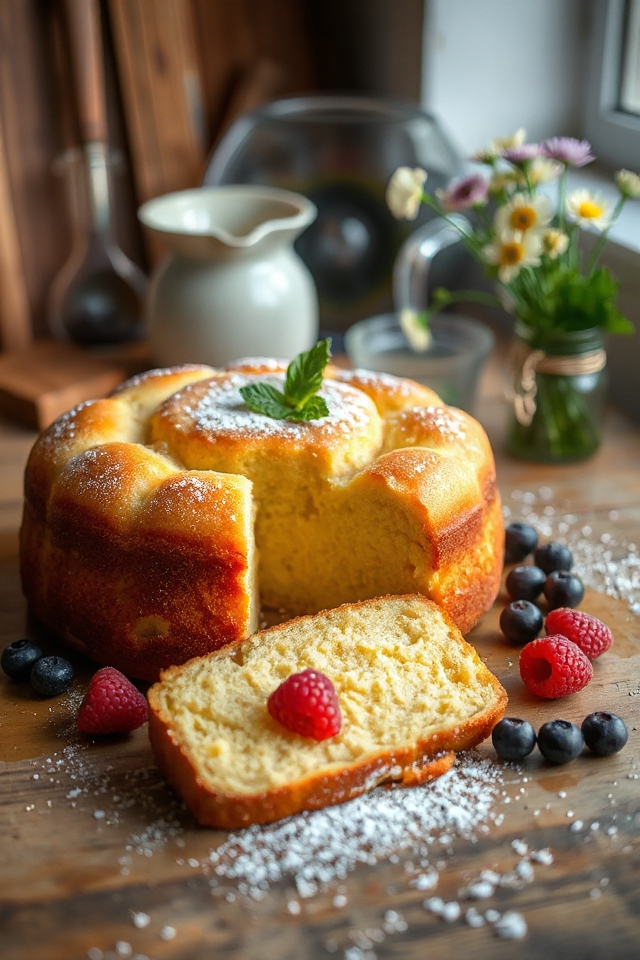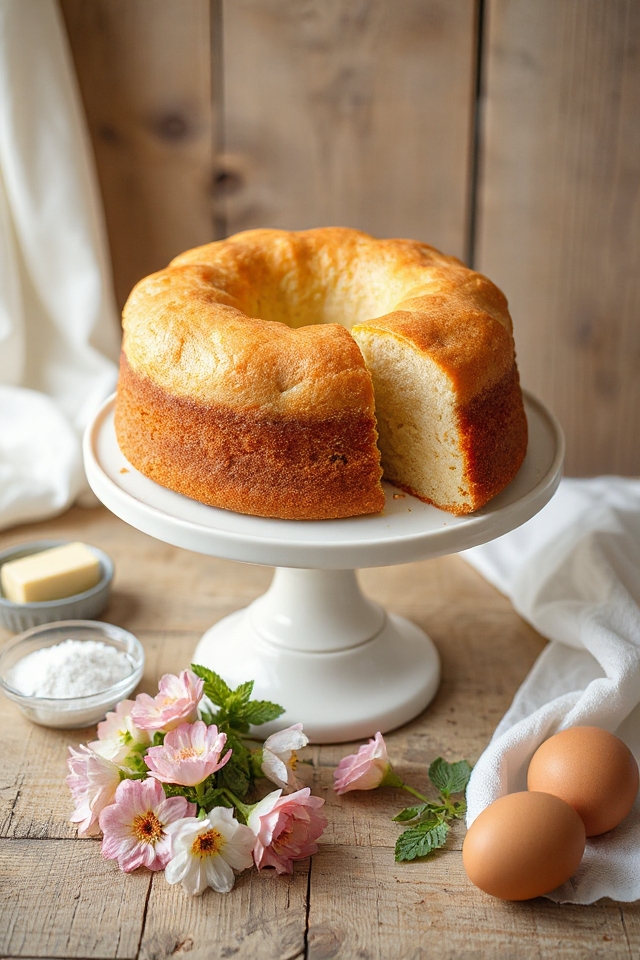Why You’ll Love This Butter Cake Recipe
You’re going to love this butter cake recipe for its simplicity and rich flavor. It’s one of my go-to desserts because it requires minimal ingredients yet yields a moist, buttery delight. I appreciate how quickly it comes together; just cream the butter and sugar, add in eggs, and fold in the flour. The aroma that fills my kitchen while it bakes is simply irresistible. Plus, it’s versatile—I can dress it up with frosting or enjoy it plain with a dusting of powdered sugar. Trust me, this butter cake will become a favorite for gatherings or cozy nights in.
Ingredients of Butter Cake
When it comes to making a butter cake, the ingredients are quite simple, yet they come together to create something truly special. You don’t need a whole pantry full of exotic items; just a handful of staples will do. This is perfect for those days when you want to bake something comforting without too much fuss.
Plus, the scent of butter and sugar mingling in your kitchen is enough to make anyone feel at home. So, let’s gather what we need for this delightful treat.
Here’s what you’ll need to whip up your butter cake:
- 250 g unsalted butter
- 210 g caster sugar
- 4 eggs
- 1 teaspoon vanilla essence
- 200 g self-rising flour (sifted)
- 1/2 teaspoon salt
- 4 tablespoons milk
Now, let’s talk about the ingredients a bit more. Choosing good quality unsalted butter makes a difference; it’s the star of the show, after all. The butter should be at room temperature, which helps it cream beautifully with the sugar.
As for the sugar, caster sugar is great because it dissolves quickly, giving that smooth texture we all love. And while self-rising flour is convenient, if you only have plain flour on hand, you can mix in a bit of baking powder to get the same effect.
Don’t forget the eggs; they add moisture and richness. And if you’re feeling adventurous, you could even experiment with flavored extracts to give it your own twist.
How to Make Butter Cake

Making a butter cake is one of those joyous experiences in the kitchen that feels like a warm hug. To start, preheat your oven to 170°C (or about 340°F for those who prefer Fahrenheit). While that heats up, grab your trusty 9-inch cake pan and give it a good greasing and flouring. This step is key; we don’t want our lovely creation sticking to the pan like it’s auditioning for a role in a horror film.
Now, let’s get to the fun part: creaming the 250 g of unsalted butter and 210 g of caster sugar together in a large mixing bowl. Use a mixer if you have one; it’s a time-saver and does all the hard work for you. Creaming should take about 4-5 minutes until the mixture is light and fluffy—think clouds, but edible.
Then, add in those 4 eggs one at a time, beating well after each addition. You want to see that luscious texture come together, and trust me, it feels like magic. Don’t forget the 1 teaspoon of vanilla essence—this is what makes your cake smell divine.
Once your batter is beautifully blended, it’s time to fold in the dry ingredients. Gently add 200 g of sifted self-rising flour and 1/2 teaspoon of salt, mixing bit by bit. The goal here is to keep that airy texture.
After the flour is fully incorporated, pour in the 4 tablespoons of milk and give it a final mix. Now, pour that batter into the prepared cake pan, leveling it out and creating a shallow well in the center. This little trick helps the cake rise evenly, so it doesn’t look like a lopsided mountain range when it bakes.
Bake for 45-55 minutes, and when a toothpick comes out clean, your butter cake is ready to shine. Just remember, the waiting is the hardest part, but oh, the reward is so worth it.
Butter Cake Substitutions & Variations
While butter cake is a classic favorite, there are plenty of substitutions and variations that can elevate this beloved dessert.
For a dairy-free option, I’ve used coconut oil instead of butter, and it adds a lovely flavor. If you’re looking for a lighter version, try substituting applesauce for some of the butter.
You can also play with flavors—adding lemon zest or almond extract gives a unique twist. For a chocolate version, incorporate cocoa powder into the flour mix.
Don’t forget to experiment with different types of flour, like almond or whole wheat, to create your own perfect butter cake!
What to Serve with Butter Cake
After experimenting with various substitutions and flavors for your butter cake, it’s time to think about what to serve alongside this delightful dessert.
I love pairing it with fresh berries—strawberries, blueberries, or raspberries add a lovely tartness that complements the sweetness. A scoop of vanilla ice cream or a dollop of whipped cream elevates the experience, too.
If you’re feeling adventurous, drizzle a bit of warm chocolate sauce over the top. For a cozy touch, serving it with a cup of tea or coffee creates the perfect pairing.
Enjoy discovering your favorite accompaniments!
Additional Tips & Notes
To guarantee your butter cake turns out perfectly every time, I recommend using room temperature ingredients, as this helps create a smoother batter and better texture.
Don’t skip the creaming step; it’s essential for a light cake. Also, be sure to measure your flour accurately—too much can make the cake dense.
Remember to check your cake a few minutes before the timer goes off; oven temperatures can vary.
If you want to add a twist, consider incorporating citrus zest or a dash of almond extract.
Finally, let your cake cool completely before frosting for the best results. Enjoy baking!
